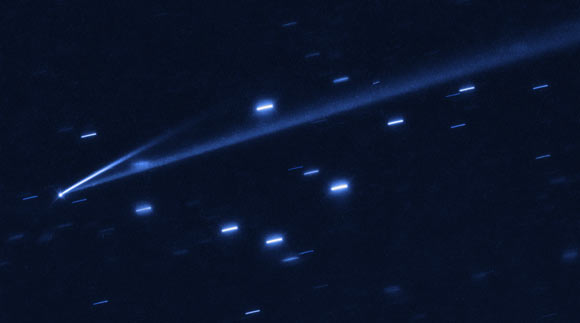Astronomers Find Color-Shifting Asteroid | Astronomy – Sci-News.com
Astronomers using the NASA Infrared Telescope Facility have caught an active asteroid called (6478) Gault in the act of changing color — in the near-infrared spectrum — from red to blue.

The asteroid (6478) Gault is seen with the NASA/ESA Hubble Space Telescope, showing two narrow, comet-like tails of debris that tell us that the asteroid is slowly undergoing self-destruction. The bright streaks surrounding the asteroid are background stars. Image credit: NASA / ESA / K. Meech & J. Kleyna, University of Hawaii / O. Hainaut, European Southern Observatory.
Discovered on May 12, 1988 by astronomer couple Carolyn and Eugene Shoemaker, Gault is about 2.5-mile (4 km) wide.
It orbits within the inner region of the main asteroid belt, approximately 214 million miles (344 million km) from the Sun.
In January 2019, images from the NASA/ESA Hubble Space Telescope and other observatories captured two narrow, comet-like tails trailing the asteroid.
Astronomers estimate that the longer tail stretches over half a million miles (800,000 km) and is roughly 3,000 miles (4,800 km) wide. The shorter tail is about a quarter as long.
“We know of about a million bodies between Mars and Jupiter, and maybe about 20 that are active in the asteroid belt. So this is very rare,” said Dr. Michael Marsset, a postdoctoral researcher in MIT’s Department of Earth, Atmospheric and Planetary Sciences.
Dr. Marsset and colleagues observed the asteroid using the NASA Infrared Telescope Facility.
They determined that the asteroid’s surface is composed mainly of silicate, a dry, rocky material, similar to most other asteroids, and, more importantly, not at all like most comets.
Comets typically come from the far colder edges of the Solar System. When they approach the Sun, any surface ice instantly sublimates, or vaporizes into gas, creating the comet’s characteristic tail.
Since the team found that Gault is a dry, rocky body, this means it likely is generating dust tails by some other active mechanism.
As the astronomers observed the asteroid, they discovered, to their surprise, that the rock was changing color in the near-infrared, from red to blue.
“We’ve never seen such a dramatic change like this over such a short period of time,” said Dr. Francesca DeMeo, also from MIT’s Department of Earth, Atmospheric and Planetary Sciences.
“We’re likely seeing the asteroid’s surface dust, turned red over millions of years of exposure to the Sun, being ejected into space, revealing a fresh, less irradiated surface beneath, that appears blue at near-infrared wavelengths.”
“Interestingly, you only need a very thin layer to be removed to see a change in the spectrum. It could be as thin as a single layer of grains just microns deep.”
So what could be causing the asteroid to turn color? The scientists believe the reason for the color shift, and the asteroid’s comet-like activity, is likely due to the same mechanism: a fast spin.
The asteroid may be spinning fast enough to whip off layers of dust from its surface, through sheer centrifugal force.
The researchers estimate it would need to have about a two-hour rotation period, spinning around every couple of hours, versus Earth’s 24-hour period.
“About 10% of asteroids spin very fast, meaning with a two- to three-hour rotation period, and it’s most likely due to the Sun spinning them up,” Dr. Marsset said.
This spinning phenomenon is known as the YORP (Yarkovsky-O’Keefe-Radzievskii-Paddack) effect, which refers to the effect of solar radiation, or photons, on small, nearby bodies such as asteroids.
“I think this study reinforces the fact that the asteroid belt is a really dynamic place,” Dr. DeMeo said.
“While the asteroid fields you see in the movies, all crashing into each other, is an exaggeration, there is definitely a lot happening out there every moment.”
The study was published in the journal Astrophysical Journal Letters.
_____
Michaël Marsset et al. 2019. Active Asteroid (6478) Gault: A Blue Q-type Surface below the Dust? ApJL 882, L2; doi: 10.3847/2041-8213/ab32ee





